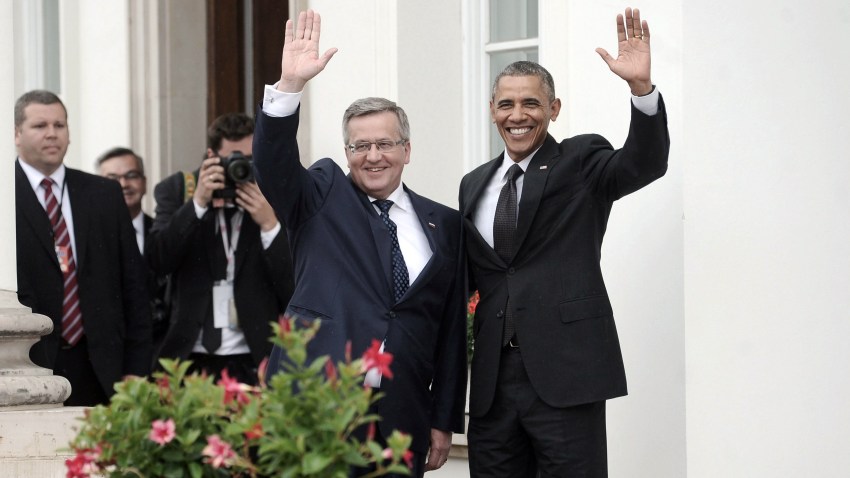Against the backdrop of ongoing tensions with Russia, President Barack Obama began a four-day trip to Europe this week. His first stop was Poland, a NATO ally celebrating 25 years of independence from Soviet domination. As Obama stood next to Polish Prime Minister Donald Tusk, the situation in Ukraine was a central theme of his remarks. The United States and Poland are “absolutely united in the need to stand with the Ukrainian people as they move forward,” Obama declared.
In Warsaw, Obama also announced a $1 billion “European Reassurance Initiative” to support regional partnerships and fund U.S. presence in the region.
He called the fund “a powerful demonstration of America’s unshakeable commitment to our NATO allies.”
The new initiative is a “much-needed step of President Obama’s administration and an important commitment to the security and territorial integrity of Central Europe,” says Simona Kordosova of the Atlantic Council in an email to Trend Lines. The fund still requires approval from the U.S. Congress, however, and therefore “doesn’t provide any immediate, visible assistance for the region,” she says.
Kordosova adds that Poland continues to worry that even if the money comes through, it won’t be enough to deter further Russian aggression. Poland wants “more tangible reassurance measures to be put in place, such as a permanent ground presence of NATO troops,” she explains.
Poland, for its part, is “preparing to strengthen its defense efforts” according to a statement from Tusk. He indicated that Poland would call on other NATO members
to increase their own defense expenditures at the upcoming NATO summit in Wales later this year. Poland currently spends less than 2 percent of GDP on defense, though it has spent more in previous years.
This was welcome news to Defense Secretary Chuck Hagel, who reiterated the long-standing U.S. frustration with low European defense expenditures in remarks at NATO headquarters in Brussels on Wednesday. He suggested that other NATO members follow the example of Poland, as well as that of the Czech Republic, to make “new commitments” to increase defense spending. “Over the long term,”
he warned, “current spending trends threaten NATO’s integrity and NATO’s capabilities.” Similar statements from previous defense secretaries have generally gone unheeded.
The United States and Poland have a number of concrete security cooperation activities in the works. According to a White House fact sheet on the U.S.-Poland relationship, the United States will continue to station fighter aircraft in the country as well as other forces on a rotating basis. Some of the new $1 billion fund would be used to support training for the U.S. aviation detachment in Poland. In 2012, the stationing of U.S. personnel in Poland as part of this detachment represented the first full-time U.S. military presence in the country.
The U.S. and Poland
are also implementing a Program for Solidarity and Partnership to encompass cooperation on special forces, training and defense industrial projects.
One of the most high-profile projects in the works is a planned U.S. missile defense site in Poland, operated by the U.S. Navy, planned for deployment in 2018 to complement a planned site of the same type in Romania. The system is part of the Obama administration’s European Phased Adaptive Approach (EPAA) for missile defense, announced in 2009, which replaced the Bush administration’s plan to place a “third site” for missile defense in Eastern Europe to complement sites in Alaska and California.
Kordosova calls the planned missile defense site “one of the most tangible signs of U.S. commitment to the region.” She says that the United States should ensure that the EPAA, which has already been adjusted in response to technological and budgetary developments, moves forward as planned “regardless of external factors.”
In addition, Poland is planning to develop its own theater missile defense system, in part in reaction to the prospect of Russian missiles stationed in the bordering Russian enclave of Kaliningrad.* At a conference in May, Vice Chairman of the Joint Chiefs of Staff Adm. James Winnefeld
called the Polish decision a “smart move,” though he also said that it would be easier to network with the U.S. system if Poland purchased U.S. technology.
For his part, Secretary of State John Kerry, who also visited Poland this week, spoke about the other tasks that Poland and the United States can accomplish together at the signing of a new “innovation framework” between the two nations. These included cooperation on climate change, a common topic of Kerry’s public statements, and closer trade relations through the Trans-Atlantic Trade and Investment Partnership (TTIP). These various elements are part of a “larger vision for the economic future,” he said.
*
Editor's note: This sentence was revised for clarity.

